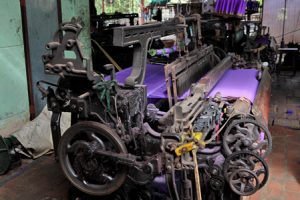[breadcrumb]
How a Weaver Can Get Mesothelioma by Occupational Exposure to Asbestos
Weavers work with various textiles and combine more than one material. They may work with various types of materials, including natural fiber, synthetic fiber, yarn, fabric or other items to help manufacture apparel, towels, textile bags and sheets.
Weavers often work in textile and fabric finishing and fabric coating mills. Asbestos weavers weaved asbestos fibers into cloth at textile mills. Many mills made products that wove asbestos into them to make them stronger and better insulated. They may have wove these fibers together with vegetable fibers, animal fibers or synthetic plastics. Many asbestos-based textiles used chrysotile asbestos, which is a known carcinogen that can result in deadly diseases. When weavers worked with these products, they could have breathed in asbestos fibers that became airborne or the dust that was created during the process.
Common job duties of weavers and textile knitting, and weaving machine setters, operators and tenders include:
- Set up, operate or tend machines that knit, weave, loop or draw in textiles
- Adjust machine heating mechanisms, tensions and speeds to manufacture products
- Install, level and align various machine components, including gears, chains, dies, cutters and guides
- Start and stop machines
- Inspect woven cloth to detect defects in the weave
- Inspect products to ensure they meet quality standards
Locations in the United States with the Highest Employment Rates for Weavers
According to the U.S. Bureau of Labor Statistics, there are currently 21,190 textile knitting, and weaving machine setters, operators and tenders. States with the highest employment rates for these workers include:
- Georgia
- North Carolina
- South Carolina
- California
- Alabama
Similar Occupations as Weavers
Some occupations that are similar to weavers include:
- Textile winding, twisting and drawing out machine setters, operators and tenders
- Textile bleaching and dyeing machine operators and tenders
- Inspectors, testers, sorters, samplers and weighers
- Supervisors and managers of production and operating workers
Lawsuits and Settlements Involving Weavers
There are some cases that have been filed against textile companies. For example, a former shipfitter’s estate sued a manufacturer of asbestos cloth and rope that was used in the ships where the man worked. The suit was filed against several manufacturers, including Uniroyal, Garlock Sealing Technologies and Johns Manville. The jury found them responsible for the man’s mesothelioma and death and awarded his estate $250,000 and $1.6 million for his widow’s loss of consortium.
A shipyard storeroom worker filed a lawsuit against Raymark Industries, the manufacturer of asbestos cloth that he was exposed to while working at the storeroom from 1964 to 1992. He often cut pieces of cloth for orders and inhaled asbestos dust during this process. He developed mesothelioma due to this exposure.
Studies Related to Textiles and Asbestos
There have been a few studies that have explored the connection between textiles and asbestos. Several studies have examined the risk of exposure to chrysotile asbestos in textile factory workers and found that there was a significant increase in lung cancer mortality rates when compared to the general population and this increase correlated to the workers’ asbestos exposure level.
A National Institute for Occupational Safety and Health study identified 170 deaths stemming from mesothelioma, asbestosis and lung cancer among workers at an asbestos textile, friction and packing plant who were exposed to asbestos through 1975.
A 2009 study published in Occupational and Environmental Medicine theorized that textile workers were exposed to chrysotile asbestos in at least four plants in North Carolina and that these workers had an increased risk of lung cancer and asbestosis if they had cumulative exposure.
Types of Asbestos Products Used by Weavers
Weavers may have helped create asbestos-containing products, such as:
- Aprons
- Canvas
- Carpeting
- Cloths
- Electrical cloth
- Filter paper
- Fire blankets
- Fire draperies and curtains
- Firefighter uniforms
- Glassblower mitts
- Gloves
- Ironing board covers
- Metal mesh blankets
- Motorsport uniforms
- Oven mitts
- Pipe coverings
- Pot holders
- Prison cell padding
- Protective clothing
- Upholstery
- Welder’s blankets
They may have also come into other asbestos-containing products, including:
- Cords
- Protective clothing
- Ropes
- Tapes
- Threads
- Wicks
- Yarns
Manufacturers of Asbestos Products Used by Weavers
Some of the manufacturers who were known to have produced asbestos textile cloth and garments or use asbestos that weavers may have been exposed to include:
- Amatex Corp.
- Anchor Packing Co.
- Armstrong World Industries
- Asten Group, Inc.
- Atlas Turner, Inc.
- Avondale Mills Textile Mill
- Koppers Co. Inc.
- Celotext Corp.
- CertainTeed Corp.
- Coats & Clark Textile Mill
- Coats & Clark Thread Company
- Dresser Industries, Inc.
- Duke Power
- Du Pont De Nemours and Company, Inc.
- GAF Corporation
- Garlock, Inc.
- K. Porter Co.
- Hogansville Stark Mills
- Johns Manville Corp.
- P. Stevens
- Laclede Christy Works
- Minnesota Mining and Manufacturing
- National Gypsum
- Nicolet
- Pacor Inc.
- Philip Carey Manufacturing Co.
- Raybestos-Manhattan, Inc.
- Raymark Industries
- Regal Textile
- Southern Asbestos Company
- Southern Textile Company
- Thermoid Corp.
- Uniroyal
- Wheeler Protective Apparel, Inc.

